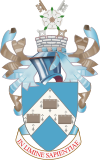University of York
 | |
| Latin: Universitas Eboracensis | |
| Motto | Latin: In limine sapientiae |
|---|---|
Motto in English | On the threshold of wisdom |
| Type | Public research university |
| Established | 1963 |
| Endowment | £7.85 million (2024)[1] |
| Budget | £515.5 million (2023/24)[1] |
| Chancellor | Heather Melville[2] |
| Vice-Chancellor | Charlie Jeffery[3] |
Academic staff | 2,615 (2022/23)[4] |
| Students | 22,510 (2022/23)[5] |
| Undergraduates | 15,425 (2022/23)[5] |
| Postgraduates | 7,085 (2022/23)[5] |
| Location | Heslington, York , England |
| Campus | Heslington West, Heslington East, and King's Manor |
| Colours | Dark blue and dark green[6] |
| Affiliations | |
| Website | york |
 | |
The University of York[7] (abbreviated as Ebor or York for post-nominals) is a public collegiate research university in York, England. Established in 1963, the university has expanded to more than thirty departments and centres, covering a wide range of subjects.
South-east of the city of York,[8] the university campus is about 500 acres (200 hectares) in size.[9] The original campus, Campus West, incorporates the York Science Park and the National Science Learning Centre, and its wildlife, campus lakes and greenery are prominent. In May 2007 the university was granted permission to build an extension to its main campus, on arable land just east of the nearby village of Heslington. The second campus, Campus East, opened in 2009[10] and now hosts five colleges and three departments as well as conference spaces, a sports village and a business start-up 'incubator'. The institution also leases King's Manor in York city centre. The university had a total income of £515.5 million in 2023–24 of which £100.4 million was from research grants and contracts, with an expenditure of £379.4 million.[1]
York was one of the first of the plate glass universities established in the 1960s, and runs a distinctive collegiate system, which currently consists of eleven colleges.[11] The eleventh college, David Kato, opened in 2022.[12][13] The university is a member of regional research groups including the N8 Group and White Rose University Consortium as well as the national Russell Group.
History
[edit]Origins
[edit]The first petition for the establishment of a university in York was presented to James I in 1617.[14] In 1641, a second petition was drawn up but was not delivered due to the English Civil War in 1642.[15] A third petition was created in 1647 but was rejected by Parliament.[15] In the 1820s there were discussions about the founding of a university in York, but this did not come to fruition due to the founding of Durham University in 1832.[15] In 1903, F. J. Munby and the Yorkshire Philosophical Society, among others, proposed a "Victoria University of Yorkshire".[16]
Oliver Sheldon a director of Rowntree's and co-founder of York Civic Trust, was a driving force behind the campaign to found the university.[17]
Establishment
[edit]John Bowes Morrell was the driving force behind the university's establishment.[14] York accepted its first students the year of Morrell's death, 1963, opening with 216 undergraduates, 14 postgraduates, and 28 academic and administrative staff.[18] The university started with six departments: Economics, Education, English, History, Mathematics, Politics.[15] At the time, the university consisted of three buildings, principally the historic King's Manor in the city centre and Heslington Hall, which has Tudor foundations and is in the village of Heslington on the edge of York. A year later, work began on purpose-built structures on the Heslington Campus, which now forms the main part of the university.
Baron James of Rusholme, the university's first Vice-Chancellor, said of the University of York that "it must be collegiate in character, that it must deliberately seek to limit the number of subjects and that much of the teaching must be done via tutorials and seminars".[19] Due to the influence of Graeme Moodie, founding head of the Politics Department, students are involved in the governance of the university at all levels, and his model has since been widely adopted.[20]
York's first two Colleges, Derwent and Langwith, were founded in 1965, as was the University of York Library.[21] These were the first residential colleges. They were followed by Alcuin and Vanbrugh in 1967 and Goodricke in 1968. In 1972 this was followed by Wentworth College.[22]
The university was noted for its inventive approach to teaching. It was known for its early adoption of joint honours degrees which were often very broad such as history and biology. It also took an innovative approach to social science introducing a five-year-long degree in the subject.[23]
Expansion
[edit]After 1972 the construction of Colleges ceased until 1990 with the foundation of James College. Initially James was intended to be a postgraduate only college. However, the university began to expand rapidly, almost doubling in size from 4,300 to 8,500 students.[24] In 1993, therefore it was decided that the college should become open to undergraduates.[25] The expansion of student numbers also resulted in the creation of more accommodation by the university, which was named 'Halifax Court'; the members of Halifax Court were members of other colleges, however, soon formed their own Junior Common Room.[26] In 2002, Halifax Court was made a full college of the university and was renamed Halifax College.

In 2003, the university set out plans to create a campus for 5,000 additional students, and to introduce a number of new subjects such as law and dentistry.[27][28][29] For a number of years, the university's expansion plans were limited by planning restrictions. The City of York planning conditions stipulate that only 20% of the land area may be built upon, and the original campus was at full capacity.[30]
In 2004, plans were finalised for a 117 hectare extension to the campus, initially called Heslington East, designed to mirror the existing Heslington West campus. They are now known as Campus East and Campus West. The plans set out that the new campus would be built on arable land between Grimston Bar park and ride car park and Heslington village. The land was removed from the green belt especially for the purpose of extending the university. After a lengthy consultation and a public inquiry into the proposals[31] in 2006, the Secretary of State for Communities and Local Government gave the go-ahead in May 2007.[32]

In May 2008 the City of York planners approved the design for the residential college, Goodricke. In The Press on 28 July 2008, Shepherd Construction was named as the preferred contractor for the Goodricke College buildings.[33] The proposal included landscaping the whole area, constructing a lake with marsh borders, planting light woodland and many specimen trees, and maximising biodiversity.
Construction began in 2008, with the first buildings, including Goodricke college, coming into use in October 2009.[10] It was decided that rather than create a new college that an existing college should be moved. Goodricke College was selected for this and moved onto the new campus in 2009 with James taking over its building on Campus West. Goodricke was officially opened by the Duke of York in April 2010.[34] In 2012, the same process took place with Langwith moving to Campus East and Derwent taking over its previous buildings. In 2014 Campus East saw the establishment of the ninth college, named Constantine College after the Roman emperor Constantine the Great, who was proclaimed Augustus in York in 306 AD.[35]
Work began in December 2019 to build two new colleges on Campus East. These will comprise around 1,400 new student bedrooms as well as new social spaces. The university says that "development has been designed to optimise the beautiful landscape and will be built with respect for the existing ecological diversity around the lake".[36]
Campus
[edit]Campus West
[edit]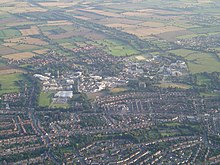
In 1964, work began on the campus facilities in the grounds of Heslington Hall. The marshy land was drained, the winding lake that dominates the campus was built, and the area was landscaped. The original buildings were designed by architects Sir Andrew Derbyshire and Sir Stirrat Johnson-Marshall, with input also from the Vice-Chancellor Lord James, Professor Patrick Nuttgens[37][38] and the Registrar, John West-Taylor.[39] The new structures were assembled using the CLASP system of prefabricated construction, hence York's inclusion among the so-called plate glass universities.[23] The buildings are connected by numerous covered walkways and bridges. Most of the university's arts departments occupy premises in the college buildings, while many of the science departments have their own buildings.
Central Hall
[edit]A landmark building is Central Hall, a half-octagonal concert hall used for convocations and examinations, as well as theatrical and musical performances. It is a Grade II-listed building, as is the West campus landscape.[40] It has played host to the Wailers, George Melly, Soft Machine, Pink Floyd, and Paul McCartney. Performances by big-name acts have been rarer at the university following a 1985 the Boomtown Rats concert, during which the cover of the orchestra pit was damaged.[41] A ban on pop performances, and in particular dancing, in Central Hall was imposed by the university, although it has occasionally been relaxed. Central Hall is still used for classical concerts and since a rock concert was held there on 13 March 2010 it has been available again for full booking. Public concerts are regularly held in the music department's Sir Jack Lyons Concert Hall, the Arthur Sykes Rymer Auditorium and in some of the colleges.
University library
[edit]The University of York Library opened in 1965 two years after the university itself opened. The building was designed by Robert Mathews, Johnson-Marshall and partners.[42] The primary site of library comprises a series of three linked buildings to the north side of the University of York's West Campus: the JB Morrell, the Raymond Burton, and the Fairhurst buildings. Originally just consisting of the JB Morrell, in 2003 the Raymond Burton library was added to the site, designed by Leach Rhodes Walker architects and houses both the Humanities research reading room and the Borthwick institute for archives.[43] The Raymond Burton Library was also recently nominated for a SCONUL Design award. In 2012 the Library had a £20 million renovation incorporating the neighbouring Fairhurst building, now housing the majority of libraries study spaces including the postgraduate study lounge.[44]
A secondary site of the library is located in the King's Manor building.

Grounds
[edit]The campus lake is the largest plastic-bottomed lake in Europe.[23] The decision by Sir Andrew Derbyshire and Stirrat Johnson-Marshall to give the university a lake had two motivations: one, to give the university a distinct image and identity while also creating areas to foster community; and two, more practically to create a drainage basin for the relatively flat agricultural site as it was feared the construction of the new buildings would increase the risk of flooding.[39] The lake has attracted a large population of wild and semi-wild waterfowl, including greylag, Canada, barnacle and snow geese, coots, moorhens and large numbers of ducks, including mallards, tufted ducks, and common pochards. There is also a growing population of black swans and a few great crested grebe. Grey herons have also been sighted on the lake. The southern end of the lake has been established as a bird sanctuary. Fishing is permitted in season, on purchase of a licence. On occasions the lake has been called Scullion's Lake.[45] However, the use of this name varies, which challenges it's authenticity. It has been applied to the whole lake,[46] to the Derwent fish pond,[47] and to the end of the lake around Wentworth.[48] No historic use of the term has been found to add support to any of these terms use.
Other parts of the campus support a large rabbit population. On at least one occasion, students have been cautioned by the university for hunting rabbits.[49]
Campus West has both indoor and outdoor sports facilities, including an all-weather AstroTurf pitch and County standard cricket pitch. A large, tent-like structure allows for indoor sport, gymnastics and dance.
In 2013 it was reported that the university was planning a major redevelopment of Campus West, which would also result in the creation of a tenth college.[50]
Heslington Hall
[edit]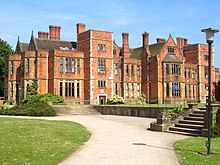
Heslington Hall is a Grade II* listed rebuilt manor house consisting of a central nine-bay two-storey block with attics and two two-storey wings at each end. It is built of brick in English bond with sandstone ashlar dressings. The original Manor house was constructed in 1568 for Sir Thomas Eynns, the Secretary and Keeper of the Seal to the Council of the North; and his wife Elizabeth.[51]
At the outbreak of the Second World War, the house was vacated by the family, allowing it to be taken over by the Royal Air Force as the headquarters of No. 4 Group RAF, part of RAF Bomber Command. The hall was not re-occupied by the family after the war. In 1955 the hall was given Grade II* listed building status.[52] When the university was founded, Sir Bernard Feilden supervised its conversion into the administrative headquarters of the university.[51] The hall and University were at that time in the East Riding of Yorkshire although they are now part of the City of York.
Science Park and on-campus organisations
[edit]Next door to the university on the York Science Park are organisations including the Higher Education Academy, the Digital Preservation Coalition, the National Non-Food Crops Centre, the York Neuroimaging Centre, the York JEOL Nanocentre, the IT office of VetUK, the UK head office of AlphaGraphics, the accelerated mass spectrometry specialists Xceleron Ltd, and the Leeds, York & North Yorkshire Chamber of Commerce. The Science Park is also home to some parts of the School of Physics, Engineering and Technology. The Department of Electronic Engineering's Recording studios are located in the park and in summer 2011, the Department of Physics moved its Plasma Physics and Fusion Group to the Genesis buildings in the Science Park at the newly created York Plasma Institute,[53] and moved its Physics of Life group to the Science Park in winter 2019. York Conferences are located on the university campus.
King's Manor
[edit]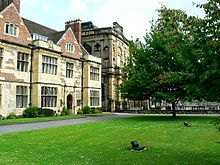
Located in York city centre, about 2 miles (3 km) from the main Heslington West campus, the historic King's Manor began as the Abbot's House of St Mary's Abbey and went on to become the headquarters of the Council of the North following the dissolution of the monasteries. For many years after 1966, the King's Manor housed the Institute of Advanced Architectural Studies (IoAAS). The IoAAS was a postgraduate institute primarily specialising in providing mid-career education for architects and others. In particular, it became well known for its one-year Diploma Course in Conservation Studies.[54] It is now home to the Archaeology, Medieval Studies and Eighteenth Century Studies departments, and is regularly used by other related departments such as History. It has a public restaurant and is used for art displays.
Not far from the King's Manor is the Minster Library, in Dean's Park. Students and staff of the university are able to use the Minster Library, which shares staff and cataloguing with the main university library, and holds the huge collection of early books belonging to the Dean and Chapter of York Minster.
The university announced in 2024 that it would stop using King's Manor for teaching and research due to the cost of maintaining the property and problems with accessibility, with the departments moving to the main Heslington campus.[55][56]
Campus East
[edit]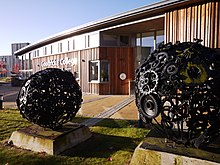
Several departments have purpose-built facilities on Campus East, including Law and the York Management School. In October 2010, several departments moved into new facilities on Campus East including the Department of Theatre, Film and Television and the Department of Computer Science.[57]
Campus East also includes the York Sports Village and a new purpose built £1.1 million Olympic-sized outdoor velodrome, the only one in Yorkshire or the North East of England.[58]
Other properties
[edit]The university owns several other properties including Catherine House, Constantine House, 54 Walmgate, and Fairfax House. The university publishes an annual code of practice for student accommodation[59] to help students living off-campus.
Organisation and administration
[edit]Colleges
[edit]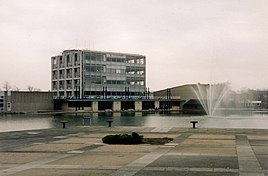
York is a collegiate university and has eleven colleges.[11] All colleges have equal status, and each has its own constitution. Each college is governed by its own College Council, which contains a combination of university staff and elected student members and is chaired by a Senior College Fellow. The day-to-day running of the colleges is managed by administrative staff from the university's Student Life and Wellbeing unit, with all the colleges coordinated by an administrative Senior Colleges Manager. In 2023, the university substituted the academic role of College Principal for the unrenumerated post of Senior College Fellow. Most colleges have a Junior Common Room for undergraduate students, which is managed by the elected Junior Common Room Committee. Some colleges retain a Graduate Common Room for postgraduate students, as well as a Senior Common Room, which is managed by elected representatives of the college's academic and administrative members. Other colleges however combine undergraduate and postgraduate representation together into student associations. The colleges are deliberately assigned undergraduates, postgraduate students and staff from a wide mixture of disciplines.[11] The Sunday Times noted, "The colleges are tight-knit communities within the university and enjoy a healthy rivalry." The colleges share practical features of the halls of residence of other UK universities, as well as the traditional Oxbridge and Durham colleges. In recent years, the university has built three new colleges on Campus East. The ninth college was founded in 2014 and was named Constantine after the Roman emperor Constantine I, who was proclaimed Augustus in York in 306 AD.[35] The tenth was founded in 2021 and named after Anne Lister. The eleventh was founded in 2022 and named after David Kato.[60]
| Name | Foundation | Named after |
|---|---|---|
| Derwent College | 1965 | River Derwent[61] |
| Langwith College | 1965[a] | Langwith Common[62] |
| Alcuin College | 1967 | Alcuin of York, scholar and advisor to Charlemagne[63] |
| Vanbrugh College | 1967 | Sir John Vanbrugh, designer of Castle Howard[64] |
| Goodricke College | 1968[b] | John Goodricke, astronomer[65] |
| Wentworth College | 1972[c] | Thomas Wentworth, 1st Earl of Strafford[22] |
| James College | 1990[d] | Lord James of Rusholme[25] |
| Halifax College | 2002[e] | Edward Wood, 1st Earl of Halifax[26] |
| Constantine College | 2014 | Emperor Constantine the Great[35] |
| Anne Lister College | 2021 | Anne Lister, Yorkshire landowner and diarist[66] |
| David Kato College | 2022 | David Kato, Ugandan human rights defender[60] |
-
Halifax College
- ^ Langwith moved to the Campus East in 2012
- ^ Goodricke moved to the Campus East in 2009
- ^ Wentworth was refounded in 2001 and became a postgraduate only college.[22]
- ^ James College was originally postgraduate only, but changed to accept undergraduates in 1993.
- ^ Halifax College was originally Halifax Court, but received college status in 2002.[26]
Academic departments
[edit]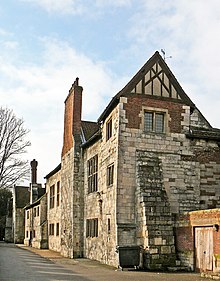
The university hosts a number of interdisciplinary research centres, including the Borthwick Institute for Archives, Centre for Renaissance and Early Modern Studies, the Centre for Eighteenth-Century Studies, the Centre for Modern Studies, the Centre for Medieval Studies, the Institute for Effective Education and the Institute for the Public Understanding of the Past. The Department of Politics hosts the Post-war Reconstruction and Development Unit and the Centre for Applied Human Rights.
Campus West hosts the National Science Learning Centre which opened in March 2006, it serves as the hub for a £51 million national network of centres dedicated to revitalising science teaching in schools. It is operated by the White Rose University Consortium (which comprises the Universities of Leeds, Sheffield and York) together with Sheffield Hallam University.
- Department of Archaeology
- Department of Architecture and the Built Environment (opening September 2025)
- Department of Biology
- Department of Chemistry
- Department of Computer Science
- Department of Economics and Related Studies
- Department of Education
- School of Physics, Engineering and Technology
- Department of English and Related Literature
- Department of Environment and Geography
- Centre for Health Economics
- Department of Health Sciences
- Department of History
- Department of History of Art
- Department of Language and Linguistic Science
- York Law School
- School for Business and Society
- Department of Mathematics
- Hull York Medical School
- School of Arts and Creative Technologies
- School of Natural Sciences
- Department of Philosophy
- School of Philosophy, Politics and Economics
- Department of Politics and International Relations
- Department of Psychology
- Institute of Railway Studies
- School for Business and Society
- Department of Sociology
- School of Arts and Creative Technologies
Governance
[edit]List of chancellors
[edit]
- George Lascelles, 7th Earl of Harewood (1962–1967)
- Kenneth Clark, Baron Clark (1967–1978)
- Michael Swann, Baron Swann (1979–1990)
- Dame Janet Baker (1991–2004)[19]
- Greg Dyke (2004–2015)
- Sir Malcolm Grant (2015–2022)
- Dr Heather Melville, OBE (2022–)
List of vice-chancellors
[edit]- Eric James, Baron James of Rusholme (1962–1973)
- Morris Carstairs (1973–1978)
- Berrick Saul (1979–1993)
- Ron Cooke (1993–2002)
- Brian Cantor (2002–2013)[19]
- Jane Grenville, acting (2013)
- Koen Lamberts (2014–2018)
- Saul Tendler, acting (2018–2019)
- Charlie Jeffery (2019–present)[67]
List of pro-vice-chancellors
[edit]- Matthias Ruth (2019–present)
- Pro-vice-chancellor of research
- Kiran Trehan (2019–present)
- Pro-vice-chancellor of partnerships and engagement
- Ambrose Field (2019–present)
- Pro-vice-chancellor of global strategy
- Tracy Lightfoot (2019–present)
- Pro-vice-chancellor of teaching, learning, and students
Finances
[edit]In the financial year ending 31 July 2024, the University of York had a total income of £515.5 million (2022/23 – £496.6 million) and total expenditure of £379.4 million (2022/23 – £496.6 million).[1] Key sources of income included £260.1 million from tuition fees and education contracts (2022/23 – £256.3 million), £54.8 million from funding body grants (2022/23 – £59.4 million), £100.4 million from research grants and contracts (2022/23 – £96.8 million), £10.1 million from investment income (2022/23 – £7.1 million) and £4.1 million from donations and endowments (2022/23 – £3.2 million).[1]
At year end, York had endowments of £7.85 million (2023 – £7.42 million) and total net assets of £472.7 million (2023 – £344.2 million).[1]
University of York Music Press
[edit]University of York Music Press (UYMP) was founded in 1995 by David Blake with Bill Colleran.[68] UYMP maintains online catalogues for composers and their music. At present, there are a total of twenty-seven house composers and thirty-one associate composers.[69] UYMP has so far published more than one thousand projects in twelve sections.[70] Among the composers whose music is published by UYMP are David Blake[71] and Anthony Gilbert.[72]
Academic profile
[edit]Rankings and reputation
[edit]| National rankings | |
|---|---|
| Complete (2025)[73] | 17 |
| Guardian (2025)[74] | 25 |
| Times / Sunday Times (2025)[75] | 17= |
| Global rankings | |
| ARWU (2024)[76] | 301–400 |
| QS (2025)[77] | 184 |
| THE (2025)[78] | 146= |
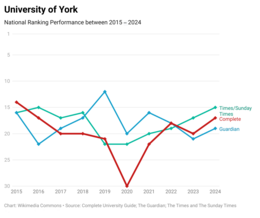
QS placed York at 162 for 2023 and at 167 in 2024.[79][80] The University of York is ranked 29th globally in the QS Sustainability Rankings for 2024.[81] All three major national rankings place York in the top 21, with The Times placing it at 17,[82] The Guardian at 21[83] and The Complete University Guide at 20 for 2023.[84]
In The Sunday Times 10-year (1998–2007) average ranking of British universities based on consistent league table performance, York was ranked 6th overall in the UK.[85] In 2000, the Sutton Trust named York as a leading university in the United Kingdom, placing it 6th overall.[86]
On 25 November 2010 York was named "University of the Year" at the Times Higher Education Awards, achieving praise from the judges for its "success in combining academic excellence with social inclusion, as well as its record in scientific discovery".[87] In 2014 York was named the eighth best university under 50 years old in the world, and first within the United Kingdom.[88]
In the Times Higher Education rankings York is listed as 34th for Life Sciences & Biomedicine in 2015.[89] In 2018 CWTS Leiden recorded there to have been 2833 publications by York between 2013 and 2016 which placed it at 425 in the world by quantity and 128 in terms of its proportion of top 10% publications.[90] Overall world rankings for York by ARWU placed it between 401 and 500 for 2021.[91] In the 2022 Shanghai Academic Ranking of World Universities the top-ranked research disciplines at York were sociology (49th), atmospheric science and economics (both ranked in the range 51–75).
Admissions and enrolment
[edit]
|
| Domicile[95] and Ethnicity[96] | Total | ||
|---|---|---|---|
| British White | 62% | ||
| British Ethnic Minorities[a] | 13% | ||
| International EU | 3% | ||
| International Non-EU | 22% | ||
| Undergraduate Widening Participation Indicators[97][98] | |||
| Female | 57% | ||
| Private School | 15% | ||
| Low Participation Areas[b] | 10% | ||
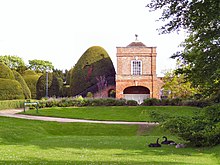
Information for entry standards gathered from the 2014/15 academic year by the HESA shows that the average student at the University of York achieved a UCAS tariff of 430 (using the previous tariff points system), the 19th highest in the UK.[99] The university gives offers of admission to 78.5% of its applicants, the joint 15th lowest amongst the Russell Group.[100]
There are around 6.2 applications for every undergraduate place, and a completion rate of 93.2% with around 80% of graduates graduating with a First/2:1.[101]
17.9% of York's undergraduates are privately educated, the joint 20th highest proportion amongst mainstream British universities.[102] In the 2016–17 academic year, the university had a domicile breakdown of 80:5:16 of UK:EU:non-EU students respectively with a female to male ratio of 56:44.[103] 56.2% of international students enrolled at the institution are from China, the third highest proportion out of all mainstream universities in the UK.[104]
In response to 'financial challenges' revealed in January 2024, the university will lower entrance requirements for international students to the equivalent of BBC at A Level or the equivalent of a 2:2 degree for postgraduate courses.[105]
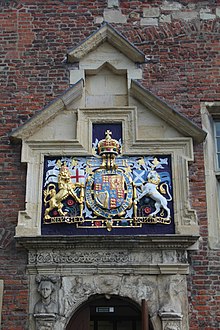
Student activities
[edit]Representation
[edit]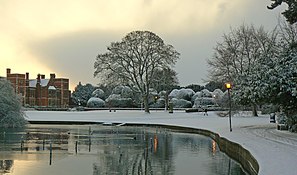
The students' union is the University of York Students' Union and is referred to as YUSU. Its membership is currently the entire student population of the university. In 2008 YUSU was able to open its first Union-run licensed venue The Courtyard. In addition to the students' union, there is the Graduate Students' Association (GSA),[106] the Students' Union for postgraduate students, which follows normal SU functions such as representing postgraduates on university committees and Council.
Each college has its own JCRC or students' association which provide a variety of services, including college events and student welfare services; they also organise the Freshers' Fortnight activities in their college.
Non-partisan political societies are well represented at the university, with the York Student Think Tank – which produces research in collaboration with national policy organisations such as IPPR, New Generation Society – an informal debating society, and The York Union Society – which competes in inter-varsity debating tournaments against other universities. There are also very active party political societies on campus with the University of York Labour Club, the University of York Liberal Democrat Society, the University of York Conservative and Unionist Association and the University of York Green Party Society; campaigning on issues both on and off campus, as well as organising debates and talks by high-profile speakers. There is also a branch of People and Planet, which campaigns on environmental and ethical issues.
Provisions for lesbian, gay, bisexual, trans and queer (LGBT) students at the university are divided among two distinct organisations. YUSU LGBTQ+ is a liberation network built into the students' union, which represents LGBTQ+ students by campaigning for issues on campus, offering welfare & support and running events for all LGBTQ+ students to attend, such as cabaret evenings and chilled mixers. The LGBTQ Social Society also organises social events aimed at LGBTQ+ students and their friends. While remaining separate, these two groups generally have strong links to each other as well as links from the student network to the Staff LGBTI+ Matters Forum, which offers largely similar provision to staff members of the university.
Student Union bars and venues
[edit]The university's Students' Union run a number of bars and venues across both campuses, namely The Courtyard, The Kitchen, The Glasshouse, The Lounge and Vanbrugh Arms.[107] Additionally, the Union also ran a venue known as D-Bar (located in Derwent College) but had to temporarily close it due to the COVID-19 pandemic.[108] D-Bar later reopened as a cafe during refurbishments of Derwent, before fully reopening in 2022.[109] Shortly after reopening as a bar, D-Bar was hosting an LGBTQ+ event when it was gate crashed by Derwent College Rugby team[110] which was called out by the then-LGBTQ+ Officers, Matt Rogan and Daniel Loyd.[111][112]
In 2020, Patrick O'Donnell, the president of YUSU, unveiled a new, purpose built venue named The Forest which would be used for a wide variety of events.[113] Later that year, Brian Terry, the then Student Activities Officer, had the venue used as part of a week long Freshers Fair, advertising societies and clubs to students in a Covid-safe environment.[114]
In 2021, The Lakeside Tap was opened to replace The Forest[115] but was closed the next year.[116]
Media
[edit]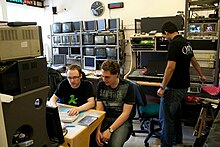
York Student Television (YSTV) was founded at the university in 1967 and is England's oldest student television station.[117] YSTV once held the world record for longest continuous television broadcast under a single director.[118] It was named the best student television station at the 2012, 2014 and 2019[119] NaSTA Awards.[120] The University of York Filmmaking Society was a student-run filmmaking group; between 1999 and 2014 its members made two feature films and many shorts, some of which were shown at national film festivals.
University Radio York (URY) is the oldest independent radio station in the United Kingdom and winner of the Student Radio Awards Best Station Award 2020.[121]
Nouse was established in 1964 and was 2005 NUS/Mirror Student paper of the year and 2009 NUS Best Student Media.[122] It has also won multiple Guardian Student Newspaper awards throughout the past decade, for both its pioneering website[123] and outstanding individual journalists. Its rival newspaper, Vision, was named Guardian Student Newspaper of the Year for three consecutive years between 2002 and 2004—the only time this has occurred in the 27-year history of the prestigious awards—and won it again in 2007.[124] In 2011, it won the award for a fifth time, making it the most awarded student newspaper in the United Kingdom. It also won Best Small Budget Publication at the 2006 NUS/Mirror National Student Media Awards.
The Lemon Press, York's satire magazine, was launched in 2009, in both print and online formats. In 2010 it won the NUS Award for Best Student Media.[125] The Yorker is an online publication set up by students as an independent company in 2007; it was nominated for the Guardian Student media awards[124] after running for only a few months.
York Student Cinema (YSC), operating since the late 1960s, show around 30 films a term using a professional 35 mm projector, an industry standard Christie CP2000 digital projector, and a full size CinemaScope screen in one of the largest rooms on campus. It has won the BFFS film society of the year award several times and celebrated its 50th anniversary in 2016.
In 2019, the History of Art department began publishing Aspectus, an annual research journal edited by current postgraduates within the department.
Sports
[edit]The university teams play in black-and-gold colours. York is a member of British Universities and Colleges Sport (BUCS) and has 65 teams participating.[126] At the end of the 2013/14 BUCS season York came 38th out of 145 participating institutions.[127]
As well as BUCS every summer term the university take part in the Roses Tournament, a sports competition against Lancaster University, which is the largest inter-university tournament in Europe.[128] The venue of the event alternates each year between York and Lancaster, and involves numerous sports clubs, including the conventional (football, hockey) and the more unusual (octopush, ultimate frisbee). As of 2018[update] York are leading Lancaster with 27 wins to 26, with one draw in 1974.[129][130]
The university has also previously also been in the White Rose Varsity Tournament. This started in 2005 against York's other university, York St John University. York won all six of the tournaments held.[131] In 2011 attempts to try and increase the competitiveness of the competition saw York St John replaced by the University of Hull.[132] York won all 3 tournaments against Hull, which resulted in it being scrapped in 2013.[133]
In 2014 a new tournament, "College Varsity", was created, which was held between the colleges of the University of York and the colleges of Durham University.[134]
Arts
[edit]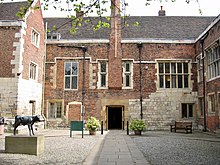
The University of York Music Society and the University of York Drama Society[135] are two of the largest student societies on campus; with each having performances and/or concerts every week during term. Central Hall Musical Society performs a number of shows and showcases every year.
Other performing societies include the Gilbert and Sullivan Society, PantSoc who stage a student-written pantomime three times a year, and York ComedySoc, one of the most active comedy societies in the UK, putting on a show every week along with workshops in stand-up, improv and sketch writing/acting. ComedySoc sends two shows to the Edinburgh Fringe each year: The Shambles, ComedySoc's in-house improv comedy troupe and The Dead Ducks[citation needed], ComedySoc's in-house sketch comedy troupe. Both troupes perform throughout the year on campus and in/around York and have received critical acclaim for their shows at the Edinburgh Fringe.
Long Boi
[edit]Long Boi was a 70-cm tall Indian Runner-Mallard Duck cross that lived by Derwent College, and became an unofficial mascot to the university.[136] In 2022 students campaigned to erect a life-sized statue of Long Boi due to his 'cultural significance' and 'contribution to student life'. In response, the union president said that he would explore possible options to construct a statue.[137] In spring 2023, after several months without a confirmed sighting, the university announced that Long Boi was presumed to be dead.[138]
A fundraising campaign raised enough money to commission a life-size bronze statue of Long Boi by sculptor Neil Mason.[139][140] The statue was formally unveiled by BBC Radio Presenter Greg James in The University of York's Central Hall on 26 September 2024.[141]
Notable alumni and academics
[edit]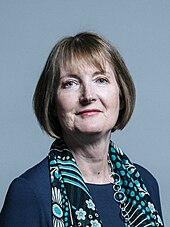
York has a large number of alumni who have been active in politics, including at least twenty Members of the United Kingdom Parliament, five members of the House of Lords, two Members of the Scottish Parliament, one Member of the European Parliament and several ministers of other governments around the world. The former President and former Prime Minister of Portugal Aníbal Cavaco Silva, completed his doctorate in economics at York.[142] The former Governor-General of Belize Colville Young holds a doctorate in linguistics from York.[143] The Senior Vice President of the World Bank Group Dr Mahmoud Mohieldin holds a master's degree in Economic and Social Policy Analysis from York.
The university is also represented by alumni educated in the liberal arts such as English literature, social sciences, economics, philosophy, medieval history, and music. The author Anthony Horowitz attended York and graduated in 1973 with a degree in English literature and art history.[144] Greg Dyke, Chair of the Football Association and British Film Institute, is a former student, and graduated in 1974 with a BA in Politics, returning to York as university Chancellor from 2004 to 2015. Writer, critic and broadcaster, Victor Lewis-Smith, studied music in the late 1970s. The current Director of the Natural History Museum, Sir Michael Dixon, has a PhD in zoology from York.[145] Youtuber and web developer Tom Scott graduated with a degree in linguistics from York.[146] Businesswoman and Dragons' Den star Sara Davies graduated from York with a business degree in 2006.[147]
More recently, due to expansion into areas of technology, it has also produced notable computer scientists, such as the Ethereum co-founder Gavin Wood,[148] computer scientist Chris Lilley,[149][150] and computational biologist Sue Jones.[151]
Prominent academics associated with the University of York include the distinguished literary teacher F. R. Leavis and anti-apartheid activist Adrian Leftwich,[152] and York doctorate, Professor Jennifer Smith (sociolinguist), FRSE, now at the University of Glasgow studying Scottish dialects.[153]
See also
[edit]- Armorial of UK universities
- List of UK universities
- Plate glass university
- White Rose Theatre, theatre company originating at the university
- York College, further education college in York
- York St John University, another university in York
Notes
[edit]- ^ Includes those who indicate that they identify as Asian, Black, Mixed Heritage, Arab or any other ethnicity except White.
- ^ Calculated from the Polar4 measure, using Quintile1, in England and Wales. Calculated from the Scottish Index of Multiple Deprivation (SIMD) measure, using SIMD20, in Scotland.
References
[edit]- ^ a b c d e f "Annual Report and Financial Statements 2024" (PDF). University of York. Retrieved 23 December 2024.
- ^ "The Chancellor". University of York. Archived from the original on 6 December 2022. Retrieved 6 December 2022.
- ^ "Professor Charlie Jeffery appointed to Vice-Chancellor at the University of York". Staff News. The University of Edinburgh. Archived from the original on 15 November 2018. Retrieved 3 September 2019.
- ^ "Who's working in HE?". www.hesa.ac.uk. Higher Education Statistics Agency.
- ^ a b c "Where do HE students study? | HESA". hesa.ac.uk. Higher Education Statistics Agency.
- ^ Communications Office (22 October 2009). "Colour". Publications – Visual Identity. The University of York. Archived from the original on 6 October 2013. Retrieved 13 November 2011.
- ^ "Using the logo – Our name". Communications. The University of York. 7 March 2011. Archived from the original on 19 August 2016. Retrieved 13 November 2011.
- ^ "How to reach the university". University of York. Archived from the original on 25 February 2012. Retrieved 27 February 2008.
- ^ "Explore our Campus" (PDF). University of York. April 2017. Archived (PDF) from the original on 27 July 2018. Retrieved 13 August 2017.
- ^ a b "Goodricke College – Campus development, The University of York". The University of York. 4 October 2010. Archived from the original on 5 October 2012. Retrieved 29 May 2011.
- ^ a b c "Colleges". University of York. Archived from the original on 26 September 2022. Retrieved 6 October 2022.
- ^ "David Kato – David Kato, University of York". University of York. Archived from the original on 6 October 2022. Retrieved 6 October 2022.
- ^ "New residences". Archived from the original on 1 February 2020. Retrieved 20 November 2021.
- ^ a b "Our History: Foundations". University of York. Archived from the original on 26 October 2020. Retrieved 21 January 2015.
- ^ a b c d "History of the University". University of York. Archived from the original on 25 October 2020. Retrieved 20 January 2015.
- ^ "The history of the Society". The Yorkshire Philosophical Society. Archived from the original on 27 August 2006. Retrieved 18 October 2006.
- ^ "Oliver Sheldon Court". Goodricke College. Archived from the original on 22 January 2015. Retrieved 21 January 2015.
- ^ "Our History: The 1960s". University of York. Archived from the original on 26 September 2020. Retrieved 21 January 2015.
- ^ a b c "Chancellors and Vice-Chancellors of the University". University of York. Archived from the original on 5 March 2008. Retrieved 28 April 2008.
- ^ Afshar, Haleh (16 August 2007). "Obituary: Graeme Moodie – Education". The Guardian. London. Archived from the original on 12 December 2019. Retrieved 3 May 2009.
- ^ "University of York". york.ac.uk. Archived from the original on 21 January 2022. Retrieved 21 January 2022.
- ^ a b c "College history". Wentworth College. Archived from the original on 22 January 2015. Retrieved 21 January 2015.
- ^ a b c Beloff, Michael (1968). "6". The Plateglass Universities. Secker & Warburg.
- ^ "Our History: The 1990s". University of York. Archived from the original on 26 October 2020. Retrieved 21 January 2015.
- ^ a b "History of the College". James College. Archived from the original on 6 October 2017. Retrieved 21 January 2015.
- ^ a b c "History of Halifax College". Halifax College. Archived from the original on 24 August 2017. Retrieved 21 January 2015.
- ^ Garner, David (27 February 2003). "University outlines plans for new campus". The University of York. Archived from the original on 29 July 2018. Retrieved 29 May 2011.
- ^ Chilvers, Mike (14 May 2004). "University threat to 'last farm'". BBC News. Archived from the original on 19 September 2016. Retrieved 29 May 2011.
- ^ Curtis, Polly (30 April 2004). "York set for £500m expansion". The Guardian. London. Archived from the original on 12 December 2019. Retrieved 29 May 2011.
- ^ "Masterplan and principles – Campus development". The University of York. 4 May 2011. Archived from the original on 10 April 2011. Retrieved 29 May 2011.
- ^ "University of York Heslington East planning application". City of York Council. Archived from the original on 25 September 2006. Retrieved 18 October 2006.
- ^ "York can build new £500m campus". BBC News. 25 May 2007. Archived from the original on 30 August 2007. Retrieved 29 May 2011.
- ^ Aitchison, Gavin (28 July 2008). "Work starts on new university campus". The Press. Archived from the original on 9 October 2012. Retrieved 29 May 2011.
- ^ "Prince Andrew officially opened Goodricke College". The Northern Echo. 29 April 2010. Archived from the original on 1 February 2020. Retrieved 29 May 2011.
- ^ a b c Parker, Fiona (22 August 2013). "New college will be called 'Constantine'". Nouse. Archived from the original on 23 September 2018. Retrieved 23 August 2013.
- ^ "New residences". University of York. Archived from the original on 1 February 2020. Retrieved 1 February 2020.
- ^ "Professor Patrick Nuttgens". Daily Telegraph. 4 April 2004. ISSN 0307-1235. Archived from the original on 12 January 2022. Retrieved 17 September 2018.
- ^ MacCarthy, Fiona (17 March 2004). "Obituary: Patrick Nuttgens". The Guardian. Archived from the original on 2 February 2019. Retrieved 17 September 2018.
- ^ a b Derbyshire, Sir Andrew. "The University of York Campus: 40 Years of Growth and Change; What Next?" (PDF). The Architecture of Universities Lecture Series. Archived from the original (PDF) on 22 December 2018. Retrieved 4 March 2015.
- ^ "23 remarkable places listed in 2018". Historic England. 20 December 2018. Archived from the original on 30 December 2018. Retrieved 29 December 2018.
- ^ "The 1980s". University of York Communications Office. Archived from the original on 16 October 2006. Retrieved 18 October 2006.
- ^ "History of University of York's library revealed". York Press. 29 December 2010. Archived from the original on 9 May 2023. Retrieved 9 May 2023.
- ^ "Designing Libraries – Raymond Burton Library for Humanities Research". designinglibraries.org.uk. Archived from the original on 9 May 2023. Retrieved 9 May 2023.
- ^ "Library expansion and refurbishment – Investing in our campus, University of York". www.york.ac.uk. Archived from the original on 9 May 2023. Retrieved 9 May 2023.
- ^ Brooke Fieldhouse, John (2022). Architecture York. Matador. p. 186. ISBN 9781800464322.
- ^ "Geograph:: Heslington West". www.geograph.org.uk. Retrieved 9 October 2024.
- ^ "MSN". www.msn.com. Retrieved 9 October 2024.
- ^ Agha, Zara (9 May 2019). "15 of the best places on campus for your dissertation picture". The Tab. Retrieved 9 October 2024.
- ^ "Halifax students cautioned after killing protected wildlife" (PDF). Nouse. 21 June 2005. Archived from the original (PDF) on 18 May 2013. Retrieved 9 January 2014.
- ^ "Constantine to be followed by College Ten". Nouse. Archived from the original on 22 January 2015. Retrieved 20 January 2015.
- ^ a b "Heslington Hall, Heslington". British Listed Buildings. Archived from the original on 4 March 2016. Retrieved 11 February 2013.
- ^ Historic England. "Heslington Hall (1148497)". National Heritage List for England. Retrieved 28 April 2010.
- ^ "York Plasma Institute – York Plasma Institute, University of York". University of York. Archived from the original on 23 May 2022. Retrieved 24 May 2022.
- ^ "IoAAS examples of courses" (PDF). Archived (PDF) from the original on 11 September 2018. Retrieved 11 September 2018.
- ^ Booth, Harry (26 June 2024). "University of York announce move from King's Manor". York Press.
- ^ Morris, Nick (10 July 2024). "Opposition to university leaving historic manor". BBC News.
- ^ "The Department of Theatre Film and Television moves into its brand new home..." Department of Theatre, Film and television, University of York. 11 October 2010. Archived from the original on 10 March 2012. Retrieved 29 May 2011.
- ^ "New outdoor cycle velodrome opening in York". York Press. 26 June 2014. Archived from the original on 2 April 2015. Retrieved 4 March 2015.
- ^ "Code of Best Practice for Student Accommodation" (PDF). University of York. 17 June 2012. Archived (PDF) from the original on 17 November 2009. Retrieved 24 June 2012.
- ^ a b "New University of York college named after human rights defender, David Kato". University of York. Archived from the original on 16 June 2021. Retrieved 16 June 2021.
- ^ "History of the College". Derwent College. Archived from the original on 22 January 2015. Retrieved 21 January 2015.
- ^ "History and Mission". Langwith College. Archived from the original on 22 January 2015. Retrieved 21 January 2015.
- ^ "History of Alcuin". Alcuin College. Archived from the original on 22 January 2015. Retrieved 20 January 2015.
- ^ "Sir John Vanbrugh". Vanbrugh College. Archived from the original on 22 January 2015. Retrieved 21 January 2015.
- ^ "College History". Goodricke College. Archived from the original on 5 October 2017. Retrieved 21 January 2015.
- ^ "New University of York college to be named after Yorkshire diarist Anne Lister". 24 January 2021. Archived from the original on 25 January 2021. Retrieved 28 January 2021.
- ^ "Professor Charlie Jeffery CBE appointed York's next Vice-Chancellor". University of York. Archived from the original on 7 November 2020. Retrieved 30 April 2019.
- ^ "University of York Music Press (UYMP)". Archived from the original on 13 August 2007. Retrieved 8 July 2022.
- ^ "Composers". Archived from the original on 14 April 2022. Retrieved 8 July 2022.
- ^ "Categories". Archived from the original on 17 April 2023. Retrieved 8 July 2022.
- ^ Paul Conway (October 2013). David Blake: From note-rows to musical numbers. Tempo 67 (266): 2–17 JSTOR 43932532
- ^ Douglas Jarman (October 2004). The Music of Anthony Gilbert (Part 2). Tempo 58 (230): 38–49 JSTOR 3878736
- ^ "Complete University Guide 2025". The Complete University Guide. 14 May 2024.
- ^ "Guardian University Guide 2025". The Guardian. 7 September 2024.
- ^ "Good University Guide 2025". The Times. 20 September 2024.
- ^ "Academic Ranking of World Universities 2024". Shanghai Ranking Consultancy. 15 August 2024.
- ^ "QS World University Rankings 2025". Quacquarelli Symonds Ltd. 4 June 2024.
- ^ "THE World University Rankings 2025". Times Higher Education. 9 October 2024.
- ^ "University of York". QS Quacquarelli Symonds Limited. Archived from the original on 17 December 2021. Retrieved 17 December 2021.
- ^ "University of York". Times Higher Education. 13 November 2021. Archived from the original on 17 December 2021. Retrieved 17 December 2021.
- ^ "QS Sustainability University Rankings 2024". Top Universities. 23 June 2024. Retrieved 27 June 2024.
- ^ "University of York". The Times/The Sunday Times. Archived from the original on 6 April 2022. Retrieved 17 December 2021.
- ^ "University league tables 2022". The Guardian. Archived from the original on 6 April 2022. Retrieved 2 May 2019.
- ^ "University League Tables 2022". The Complete University Guide. Archived from the original on 6 April 2022. Retrieved 17 December 2021.
- ^ "University ranking based on performance over 10 years" (PDF). The Times. London. 2007. Archived from the original (PDF) on 14 April 2008. Retrieved 28 April 2008.
- ^ "Entry to Leading Universities" (PDF). Sutton Trust. 2000. Archived from the original (PDF) on 14 April 2008. Retrieved 28 April 2008.
- ^ "Top award for York as sector celebrates its achievements". Times Higher Education. 26 November 2010. Archived from the original on 1 December 2012. Retrieved 26 November 2010.
- ^ Morgan, John (31 May 2012). "THE 100 Under 50 university rankings: results | General". Times Higher Education. Archived from the original on 2 December 2012. Retrieved 17 August 2013.
- ^ [1] Archived 20 January 2015 at the Wayback Machine
- ^ "CWTS Leiden Ranking 2018". Centre for Science and Technology Studies, Leiden University. Archived from the original on 20 September 2018. Retrieved 7 June 2018.
- ^ "University of York". Shanghai Ranking Consultancy. Archived from the original on 17 December 2021. Retrieved 17 December 2021.
- ^ a b "UCAS Undergraduate Sector-Level End of Cycle Data Resources 2023". ucas.com. UCAS. December 2023. Show me... Domicile by Provider. Retrieved 30 April 2024.
- ^ "2023 entry UCAS Undergraduate reports by sex, area background, and ethnic group". UCAS. 30 April 2024. Retrieved 30 April 2024.
- ^ "University League Tables entry standards 2024". The Complete University Guide. Retrieved 7 June 2023.
- ^ "Where do HE students study?: Students by HE provider". HESA. HE student enrolments by HE provider. Archived from the original on 10 February 2018. Retrieved 8 February 2023.
- ^ "Who's studying in HE?: Personal characteristics". HESA. 31 January 2023. Archived from the original on 10 February 2023. Retrieved 8 February 2023.
- ^ "Widening participation: UK Performance Indicators: Table T2a – Participation of under-represented groups in higher education". Higher Education Statistics Authority. hesa.ac.uk. Archived from the original on 6 February 2023. Retrieved 8 February 2023.
- ^ "Good University Guide: Social Inclusion Ranking". The Times. 16 September 2022. Archived from the original on 22 February 2022. Retrieved 10 February 2023.
- ^ "University League Table 2017". Complete University Guide. London. Archived from the original on 27 April 2017. Retrieved 20 June 2016.
- ^ "Which elite universities have the highest offer rates". The Telegraph. Archived from the original on 12 January 2022. Retrieved 21 October 2016.
- ^ "The Times and Sunday Times University Guide 2015, University of York". The Sunday Times. London. Archived from the original on 4 March 2016. Retrieved 18 May 2015.
- ^ "Widening participation: UK Performance Indicators 2016/17". hesa.ac.uk. Higher Education Statistics Authority. Archived from the original on 27 October 2020. Retrieved 1 February 2018.
- ^ "Where do HE students study?". hesa.ac.uk. Higher Education Statistics Authority. Archived from the original on 10 February 2018. Retrieved 9 February 2018.
- ^ Jack, Patrick (18 May 2023). "OfS writes to 23 institutions over 'high levels' of Chinese students". Times Higher Education. Archived from the original on 21 May 2023. Retrieved 21 May 2023.
- ^ "University of York lowers bar for overseas students after 'financial challenges'". Financial Times. 11 January 2024. Retrieved 20 January 2024.
- ^ "University of York Graduate Students' Association | Association for Graduate Students at the University of York". www.yorkgsa.org. Archived from the original on 27 April 2020. Retrieved 1 February 2020.
- ^ "University of York's Students' Union Bars;". Archived from the original on 27 June 2021. Retrieved 27 June 2021.
- ^ "University of York's Students' Union D-Bar closed;". Archived from the original on 27 June 2021. Retrieved 27 June 2021.
- ^ Brown, Luke (25 February 2022). "£520k Derwent refurb". Nouse. Archived from the original on 16 October 2022. Retrieved 16 October 2022.
- ^ Wemyss, Kristina (24 February 2022). "Derwent College Rugby gatecrash gay and bisexual round of College dating event". Nouse. Archived from the original on 16 October 2022. Retrieved 16 October 2022.
- ^ "Yusu Lgbtq Pto on Instagram". Instagram. Retrieved 18 January 2023.
My comment on Derwent Rugby: "I am disgusted by the events that took place at the Take Me Out event on Friday; homophobia has absolutely no place here at York and to see members of Derwent Rugby participate in this bigotry is appalling. Unfortunately, apologies alone are very rarely effective in changing bigoted attitudes such as this, as they can be so easily brushed aside by those involved. Considering how severe the incident was, I strongly encourage Derwent College Rugby to show that they will not tolerate this type of behaviour and suspend the members involved from the team; I believe any actions short of this only serve to perpetuate a hostile atmosphere towards the LGBTQ+ community. I'd also like to thank the JCRC members who intervened on the night and who did their best to remove the individuals involved." – Apologies on the delay for this, this was originally supposed to be published in vision 💜
- ^ "Matt for Community & Wellbeing on Instagram: "Please see my statement on recent events that have unfolded."". Instagram. Retrieved 18 January 2023.
- ^ "University of York's Students' Union The Forest;". 14 August 2020. Archived from the original on 27 June 2021. Retrieved 27 June 2021.
- ^ "YUSU Reveal Plans for Multiple Freshers' Fairs to Allow Social Distancing". September 2020. Archived from the original on 28 September 2021. Retrieved 28 September 2021.
- ^ "University of York's Students' Union The Forest;". 12 April 2021. Archived from the original on 27 June 2021. Retrieved 27 June 2021.
- ^ "The Lakeside Tap". University of York Students' Union. Archived from the original on 16 October 2022. Retrieved 16 October 2022.
- ^ Dowdney, Mark (22 November 1967). "York TV students take to the air". The Northern Echo. p. 7.
- ^ McWhirter, Norris (1990). Guinness Book of World Records. p. 233.
- ^ York Student Television (27 April 2019). "Holy crap we won #NaSTA Best Broadcaster 2019! Thanks so much fo [sic] everyone who's been involved this past year, what an amazing team and what an amazing night". @ystv. Retrieved 12 May 2019.
- ^ "NaSTA 2014". National Student Television Awards Loughborough 2014. NaSTA. Archived from the original on 31 May 2014. Retrieved 21 October 2014.
- ^ "About Us". University Radio York. Archived from the original on 6 October 2008. Retrieved 23 December 2021.
- ^ "NUS Awards 2009". York: The Yorker. 2009. Archived from the original on 3 July 2009. Retrieved 10 August 2009.
- ^ "Student Media Awards 2009". The Guardian. London. 26 November 2009. Archived from the original on 5 October 2013. Retrieved 14 March 2010.
- ^ a b "Student Media Awards 2007". The Guardian. London. 2007. Archived from the original on 14 September 2012. Retrieved 28 April 2008.
- ^ "NUS Awards 2010 winners announced: News Archive: News". nus.org.uk. Archived from the original on 3 February 2019. Retrieved 24 June 2012.
- ^ "University Profile – University of York". British Universities and Colleges Sport. Archived from the original on 3 July 2014. Retrieved 21 January 2015.
- ^ "BUCS Point 2013/14 Season". British Universities and Colleges Sport. Archived from the original on 7 August 2018. Retrieved 21 January 2015.
- ^ "Tournaments & Events". YUSU. Archived from the original on 22 January 2015. Retrieved 21 January 2015.
- ^ "History". Roses Live. Archived from the original on 17 September 2018. Retrieved 2 June 2018.
- ^ "York are defeated in Roses". The Tab. 6 May 2018. Archived from the original on 17 September 2018. Retrieved 2 June 2018.
- ^ "York storm to fourth straight Varsity victory". Nouse. 20 February 2008. Archived from the original on 22 January 2015. Retrieved 21 January 2015.
- ^ "York St. John Sabbatical Officer voices disappointment over Varsity shake-up". Nouse. 21 January 2011. Archived from the original on 4 March 2016. Retrieved 21 January 2015.
- ^ "White Rose Varsity scrapped". Nouse. 8 August 2013. Archived from the original on 22 January 2015. Retrieved 21 January 2015.
- ^ "New College Varsity". York Vision. 29 October 2013. Archived from the original on 6 March 2016. Retrieved 21 January 2015.
- ^ "York Dramasoc website". York Dramasoc. Archived from the original on 2 May 2016. Retrieved 3 May 2016.
- ^ "Long Boi: York university duck becomes social media star". BBC News. Archived from the original on 9 December 2022. Retrieved 30 November 2021.
- ^ "Erect a statue of Longboi on campus". University of York Student's Union. Archived from the original on 9 May 2023. Retrieved 21 April 2022.
- ^ Constable, Oli; Wright, Oliver (11 May 2023). "Long Boi: Missing University of York duck presumed dead". BBC News. Archived from the original on 11 May 2023. Retrieved 23 May 2023.
- ^ Davies, Brooke (18 May 2023). "Long Boi fans trying to raise £10,000 for duck's memorial statue". Metro. Archived from the original on 23 May 2023. Retrieved 23 May 2023.
- ^ "Long Boi: Uni of York duck sculpture designs revealed". BBC News. 17 May 2024.
- ^ Gouldsbrough, Patrick (26 September 2024). "Memorial event takes place for viral duck 'Longboi' as BBC's Greg James pays tribute". The Northern Echo. Newsquest Media Group. Retrieved 26 September 2024.
- ^ "Aníbal Cavaco Silva". Archived from the original on 14 October 2007. Retrieved 20 January 2015.
- ^ East, Roger; Thomas, Richard (2003). Profiles of people in power: the world's government leaders. Routledge. pp. 52–3. ISBN 978-1-85743-126-1.
- ^ "York honours contributions to society". Grapevine (2010 Autumn/Winter). Alumni Office, University of York: 6. 2010.
- ^ "The Executive Board Sir Michael Dixon, Museum Director". Natural History Museum. Archived from the original on 9 July 2015. Retrieved 20 January 2015.
- ^ Association, Press (28 July 2004). "Student battles government over spoof site". The Guardian. ISSN 0261-3077. Retrieved 2 January 2025.
- ^ Ling, Thomas. "Who is new Dragons' Den star Sara Davies? Meet the youngest ever Dragon". Radio Times. Retrieved 16 February 2024.
- ^ "British coder revealed as brains behind bitcoin rival". The Times. Archived from the original on 12 November 2020. Retrieved 21 November 2017.
- ^ Lilley, Chris. "Biographical Details". W3C. Archived from the original on 28 July 2020. Retrieved 23 January 2017.
- ^ Wyatt, Andrew H.; Lilley, Chris (2002). SVG Unleashed. Sams. p. Back Cover. ISBN 978-0672324291.
- ^ "Sue Jones - James Hutton Institute - Information and Computational Science – BSc Biology – PhD Bioinformatics". ResearchGate. Archived from the original on 20 May 2021. Retrieved 19 May 2021.
- ^ Evans, Gavin (27 May 2013). "Adrian Leftwich: Leading anti-apartheid activist who turned state witness". The Independent. Archived from the original on 25 September 2015. Retrieved 4 March 2015.
- ^ "University of Glasgow – Schools – School of Critical Studies – Our staff – Prof Jennifer Smith". www.gla.ac.uk. Archived from the original on 9 August 2021. Retrieved 9 August 2021.


